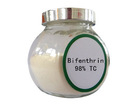Bifenthrin Suppliers, Bifenthrin Manufacturers.

Bifenthrin 95TC 2.5EC Features:
1.Insecticide of contact and stomach action
2. Effectively against broad range of foliar pests, including Coleoptera, diptera, heteroptera, homoptera, lepidoptera and orthoptera
3. It kills insects on crops including cereals, citrus, cotton, fruit, grapes, ornamentals and vegetables
| APPLICATION | Mode of action Contact and stomach action. Uses Effective against a broad range of foliar pests, including Coleoptera, Diptera, Heteroptera, Homoptera, Lepidoptera and Orthoptera; It also controls some species of Acarina. Crops include cereals, citrus, cotton, fruit, grapes, ornamentals and vegetables. Rates range from 5 g a. I. /ha against Aphididae in cereals to 45 g/ha against Aphididae and Lepidoptera in top fruit. Compatibility Not compatible with alkaline materials. | ||
| SPECIFICATION | |||
| Content | ≥10% | Appearance | Yellow liquid |
| pH/acidity(as H2SO4) | 3.0~8.0 | Water | ≤ 0.5% |
| Emulsifiability | No sediment or oil. | Persistent foam(1min) | ≤ 60 ml |
| Stability at 0±2°C,7 days | Qualified | Stability at 54±2, 14 days. | Qualified |
PHYSICAL CHEMISTRY:
Composition: Material contains 97% cis-isomer, 3% trans-isomer.
Mol. wt.: 422.9;
M.f.: C23H22ClF3O2;
Form: Viscous liquid; crystalline or waxy solid. M.p.: 68-70.6C; V.p.: 0.024 mPa (25C); KOW: logP >6;
Henry: 1.02x102 Pa m3 mol-1 (calc.)
S.g./density: 1.210 (25C);
Solubility: In water <1 g/l. Soluble in acetone, chloroform, dichloromethane, diethyl ether, and toluene. Slightly soluble in heptane and methanol.
Stability: Stable for 2 y at 25C and 50C (tech.). In natural daylight, DT50 255 d; stable 21 d at pH 5-9 (21C).
F.p.: 165C (Tag open cup); 151C (Pensky-Martens closed cup)
APPLICATIONS:
Mode of action: Contact and stomach action.
Uses: Effective against a broad range of foliar pests, including Coleoptera, Diptera, Heteroptera, Homoptera, Lepidoptera and Orthoptera; it also controls some species of Acarina. Crops include cereals, citrus, cotton, fruit, grapes, ornamentals and vegetables. Rates range from 5 g a.i./ha against Aphididae in cereals to 45 g/ha against Aphididae and Lepidoptera in top fruit.
Compatibility: Not compatible with alkaline materials.
MAMMALIAN TOXICOLOGY:
Oral: Acute oral LD50 for rats 54.5 mg/kg.
Skin and eye: Acute percutaneous LD50 for rabbits >2000 mg/kg. Non-irritant to skin; virtually non-irritating to eyes (rabbits). No skin sensitisation (guinea pigs).
NOEL: (1 y) for dogs 1.5 mg/kg daily. Non-teratogenic in rats (2 mg/kg daily) and rabbits (8 mg/kg daily).
ADI: 0.02 mg/kg.
Toxicity class: WHO (a.i.) II; EPA (formulation) II
ECOTOXICOLOGYBirds: Acute oral LD50 for bobwhite quail 1800, mallard ducks 2150 mg/kg. Dietary LC50(8 d) for bobwhite quail 4450, mallard ducks 1280 mg/kg diet.
Fish: LC50 (96 h) for bluegill sunfish 0.00035, rainbow trout 0.00015 mg/l.
Daphnia: LC50 (48 h) 0.00016 mg/l. Low solubility in water and high affinity for soil contribute to produce little impact in aquatic systems under field conditions.
Bees: LD50 (oral) 0.1g/bee; (contact) 0.01462g/bee.
Company: |
LABOR KAIFENG AGROCHEMICALS CO., LTD. |
Contact: |
Mrs.Wan |
Phone: |
15137105706 |
Mobile phone: |
+86-15137105515/+86-15137103859 /+86-15137105313 /+86-15137103863 |
Fax: |
+86-371-66819620 |
E-mail: |
rd@pesticidechina.com |
Website:
|
http://www.pesticidechina.com |
Address: |
No.57 Chengdongnan Road.Zhengzhou, Henan,China. |
Zip Code: |
450009 |